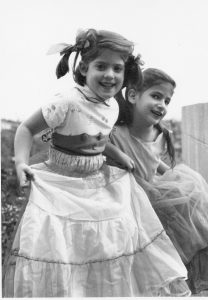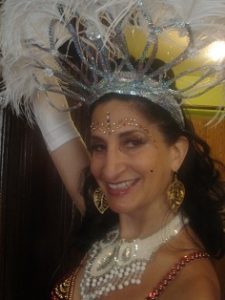My Not-So-Secret Other Life as a Dancer by Barbara Quick

Barbara Quick (right)
The memory is imprecise, like something recollected from a dream: a jewelry box, at eye level to my toddler self. My own hands in the perfection of their childish form—long-fingered, unmarked by life—reaching toward the black lacquer lid painted with blossoms. Hinging it open to animate the tiny pink-clad ballerina who otherwise waits asleep inside. Around and around she spins in her pink leotard, tutu, and pointe shoes with their crisscrossed ribbons, compelled to dance by a tinkling tune I wish I could remember now. I think it must have been something by Tchaikovsky, something that would resonate for me, later on, when I heard it on one of my parents’ LPs and, much later, when I heard it in the concert hall of the symphony orchestra where my husband (yes, my fourth) is a string-player. I was mesmerized by that little dancer in her ongoing moment of perfect grace—and in some ways, I realize now, I took her as my role model.
Along with the other little girls in my nursery school, I took a ballet class held in the clubhouse of Crestwood Hills Park, part of the co-op that had drawn my parents to buy a lot in the unsettled wilds above Kenter Canyon, north of Sunset Boulevard, just after the Second World War.
There are 8-mm films somewhere of our performances, on the outdoor stage, dressed in our little pink tutus with their stretchy, sequined straps, hands meeting in fifth position above our heads, our smiles both proud and abashed. The father of one of the children—a girl named Angela, I remember, who had the wondrous ability to drop to the stage in perfect splits—brought back child-size grass skirts and leis for all of us, from a business trip to Hawaii. Our mothers tied silk scarves around our chests, cinched in the middle, and crisscrossed over our backs.
My long brown hair was my only glory. My friend Julie, who is still my friend and still adorable, did cartwheels for her solo, her white cotton panties (insisted on by her fastidious mother) showing beneath the leg-holes of her leotard.
My father, who developed his own gorgeous black-and-white photos in a make-shift darkroom, memorialized Julie and me, as we minced and posed and giggled, thrilled at being able to wear lipstick and ladies’ hats as we posed for him.
I continued to think of myself as a dancer, even though I didn’t take classes again until high school. It was Modern Dance then, with its annoying and uncomfortable insistence on spending so much time on the floor—with its multiplicity of dimensions in which the dancer was expected to move with grace and ease. Our teacher was an undeclared Lesbian who threatened girls with twisted-up towels in the locker room, where the girls who had already developed breasts taunted those of us whose chests remained defiantly flat. The only thing I loved about Modern Dance was that it didn’t require turn-out. I was high-waisted and slender, all legs and neck, which would have been perfect for ballet if only my adductors and hip flexors hadn’t been too tight to even allow me to sit cross-legged with comfort, even as a small child.
But Modern Dance embraced and encouraged dramatic expression, which was something that came to me quite naturally. In my last year of high school—after I returned from a brief, self-funded sojourn to England to visit my friend Megan, who was working as an au pair for an American family living on Hampstead Heath—I became the class’s student choreographer, directing the dancers in what I cringe now to remember as the slight British accent I brought back with me, after only a month away.
Meanwhile I’d been taking summer theater classes from the age of nine. Theater Arts was always the elective I chose in school, even though Pacific Palisades High was filled with the offspring of theater and film professionals, and the drama teacher, Miss Wigod, informed me in her lisping voice, that she would never give me a big part. Never! My parents were nobodies—and, worse than that, we were inveterately impecunious, without even a whiff of influence or cachet. I was musical and could sing sweetly, but my voice never projected well enough for live theater (it still doesn’t now: give me a microphone and I’m happy to perform but hopeless without). But I was, no doubt about it, dramatic.
I devoured the monologues we memorized for our class productions and exams. “That’s alright, Miss Wigod,” I told her with brave resignation. “I’ll design costumes. I’ll do make-up. I’ll work on the sets.” I promised myself that I would make the most of every line of dialogue that was ever assigned to me—I would make those words, however few they were, sing with portent and meaning.
Even though I didn’t know it yet, I was honing my craft as a writer. I’d written poetry from the age of nine. (“Far into the night,” I’d written with precocious gloominess, “I see myself. I am alone.”) Poetry was my emotional lifeline and salvation from the miseries of my horribly dysfunctional family.
Dance classes continued to be a lure for me. But at the age of seventeen, after I’d graduated high school and left home, I realized that keeping a journal and writing poetry had become a practice for me. I was much more a writer than a dancer—and it seemed clear that I hadn’t any chance at all of making a career on the stage or screen. (I didn’t have the voice for the one or the face for the other.) Nonetheless, my uniform at UC Santa Cruz was a black leotard and jeans, and I continued to harbor the image of myself as someone connected by mysterious threads to the world of dance.
Twin Lifelines for a Fraught Adulthood: Writing and Dancing
In the last years of the century, finding myself a single mom, I rented a five-bedroom house in the hills of Kensington, just north of Berkeley, and took in boarders. Determined to live in a neighborhood where my little son could attend a good public school, I cooked sit-down dinners six nights a week for a changing cast of young adults from all over the world. At the height of this experiment, I had a household filled with Brazilians. One of them, a drop-dead gorgeous girl named Marianna, encouraged me to enroll in a Brazilian dance class, with the goal of both of us dancing in the upcoming San Francisco Carnaval Parade.

Barbara Quick
I became obsessed. Sometimes I took two dance classes a day, expanding my repertoire from Brazilian to every other form of dance offered by the studio, from jazz to hip-hop to West African. Eventually, I danced in six different Carnaval parades, went to Brazil twice, and learned enough Brazilian Portuguese for the songs—filled with longing, with saudade—to blossom with meaning for me.
I’ve sought out Brazilian dance classes ever since, wherever I’ve lived. I’m what I guess one could call a joyful and competent dancer, perhaps remarkable for the fact that I’m still dancing now, with a fair bit of energy and stamina, at the age of sixty-eight.
Knowing in my body what it is to dance—and, of course, being a fiction writer—allowed me to write convincingly from the point of view of a minor professional ballet dancer of the Belle Époque, the fictional Jeannette Dupres, in my latest novel, What Disappears. When the ballet memoirist Gavin Larsen, author of Being a Ballerina: The Power and Perfection of a Dancing Life, declared my novel “masterful” in the to-die-for jacket quote she wrote for my book—when Pod-de-Deux podcast host and former professional ballerina Clara Peterson agreed with Gavin in Zoom events the three of us did together this year that my novel could only have been written by a dancer—it felt as if I’d come full circle, back to that little girl who stood with such innocent awe and a sense of destiny before the twirling ballerina of that long-lost music-box.
—
Barbara Quick is best known as author of the 2007 novel Vivaldi’s Virgins, translated into over a dozen languages, made into an audiobook, still in print and currently in development as a mini-series by award-winning director Agnieszka Holland. Winner of the Discover: Great New Writers prize for her first novel, Northern Edge, Barbara was awarded the 2020 Blue Light Press Poetry Prize for her debut chapbook of poems, The Light on Sifnos. Barbara’s fourth novel, What Disappears—over a decade in the making—was published by Regal House on May 17th. Her 2010 novel from HarperTeen, A Golden Web—about the 14th century teenage anatomist Alessandra Giliani—continues to intrigue and attract historical fiction fans. A trained dancer and avid organic gardener, Barbara is based on a small farm and vineyard in the California Wine Country with her husband Wayne Roden, a vigneron and long-time violist with the San Francisco Symphony. More at BarbaraQuick.com
WHAT DISAPPEARS
Category: Contemporary Women Writers, How To and Tips

 What Disappears is a gripping multi-generational tale that begins in Tsarist Russia in the late 19th century and ends in Paris with the start of the First World War. Jeannette Dupres, one of two identical twins born to a Jewish family in dire political and financial straits, is spirited away as an infant by a Catholic family in France. The other twin, Sonya Luria, who was told her sister died at birth, has her life upended by the 1903 pogrom in Kishinev.
What Disappears is a gripping multi-generational tale that begins in Tsarist Russia in the late 19th century and ends in Paris with the start of the First World War. Jeannette Dupres, one of two identical twins born to a Jewish family in dire political and financial straits, is spirited away as an infant by a Catholic family in France. The other twin, Sonya Luria, who was told her sister died at birth, has her life upended by the 1903 pogrom in Kishinev.






















